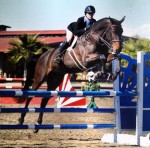Members of the UCLA equestrian team have leapt over hurdles inside and outside the horse riding arena to re-establish themselves as a club sport on campus.
The UCLA equestrian team was reinstated in 2014 after a two-year hiatus, and now consists of seven students who compete with the Intercollegiate Horse Show Association, the national platform for college equestrianism. Kristina Hambley, the team’s current president, and team member Chantel Valdivieso qualified during the regional show in March to compete at the championship at Stanford University on April 2.
“I’m definitely one of those people who never grew out of loving horses as a little girl,” said Hambley, a third-year ecology and evolutionary biology student. “For all the girls on the team, riding is important to our happiness.”
The original equestrian team, established in 2005, disbanded seven years later after the senior leadership board members of the team graduated. The remaining members were unable to finance the club, which received no outside funding from the university.
Hambley, who has been riding horseback competitively since age 7, said she was crushed to learn UCLA lacked an equestrian team when she was a first-year student.
“I spent all afternoon in Bruin Plaza at the Enormous Activities Fair looking for the equestrian team,” Hambley said. “I’d seen their old website online and hadn’t realized the team had dissolved.”
Hambley said she partnered with an anthropology graduate student and fellow equestrian rider Gwyneth Talley in 2013 to work out the logistics of establishing an equestrian team as an official club sport.
One school year and hundreds of emails to administrators later, she and Talley earned the equestrian team’s recognition as a club sport and gained membership to the Intercollegiate Horse Shows Association. The team began competing in regional competitions with just four riders during the 2014-2015 academic year.
The seven girls who now make up the club have each been riding competitively since grade school. First-year psychobiology student Hannah Erickson said her mother was involved in equestrianism and spurred her to begin riding at 7. In her hometown of Oceanside, in San Diego County, horseback riding is as common a sport as soccer or golf, she added.
“Horseback riding is like any team sport, but your one teammate is the horse,” Erickson said. “It’s an animal you can only communicate with in the way you ride.”
Erickson added the communication between horse and human is conveyed through the rider’s confidence in the saddle, which directs the horse’s precise jumps and graceful trots.
Erickson, who has trained and competed on a variety of horses, said she has found horses’ personalities and athletic abilities vary as much as humans’. She added she thinks some horses may be higher jumpers or quick on their feet, but a close bond between horse and rider is more valuable than a competitive edge.
A Dutch warmblood horse Coco, who Erickson met when she was still competing in children’s divisions, was Erickson’s closest partner and the first horse she owned.
“I was leasing (Coco) for the year, and then one day I was riding and my parents said, ‘Congratulations, you’re now the owner of the horse you’re sitting on!’” Erickson said.
She added she and Coco went on to win three championships at the Greater San Diego Region show together.
Lauren Myers, a third-year psychology student, had her own horse growing up in Seattle but traveled across the country to find opportunities to compete in international equestrian shows.
Myers said she spent more time commuting across the country participating in horse shows during the annual 12-week festival circuit than she did in her high school classes. She added she thinks the extensive travel was well worth the chance to compete against international riders.
“I would fly on a red-eye on Wednesday nights after school, arrive Thursday morning then compete until Sunday,” Myers said. “I’d just bring my books and study when I wasn’t riding.”
Commutes to practices and competitions have remained a major obligation for Myers and the members of the UCLA equestrian team. The closest facility to campus is a one-hour drive to Elvenstar barn in Moorpark.
Hambley said team members are only expected to practice a minimum of once a week, but some make the drive four times a week for hour-long sessions of practice with the horses.
“When you get to a certain level in any sport, it becomes addictive,” Hambley said. “It’s always been about going back and wanting to improve – watching your jumps get higher and form get better.”
She added cost is another major commitment for members of the team. Katarina Ivanovich, a first-year
The team doesn’t receive funding from UCLA itself because it is a newer, smaller club sport, Ivanovich said. Members must pay out of pocket or raise money independently on sites like GoFundMe.
Going forward, Hambley said the team’s main goal is to recruit more riders, including men who may be interested in joining the team, and raise funds for training and competitions. Hambley said building the equestrian team is just like developing riding technique – it requires patience and persistence.
“If you ride horses, at some point you are going to fall off,” Hambley said. “You just have to remember that you’re going to have to hit the ground a few times before you get better.”
Email McCormick at emccormick@media.ucla.edu or tweet her @Emily_Mcck.
